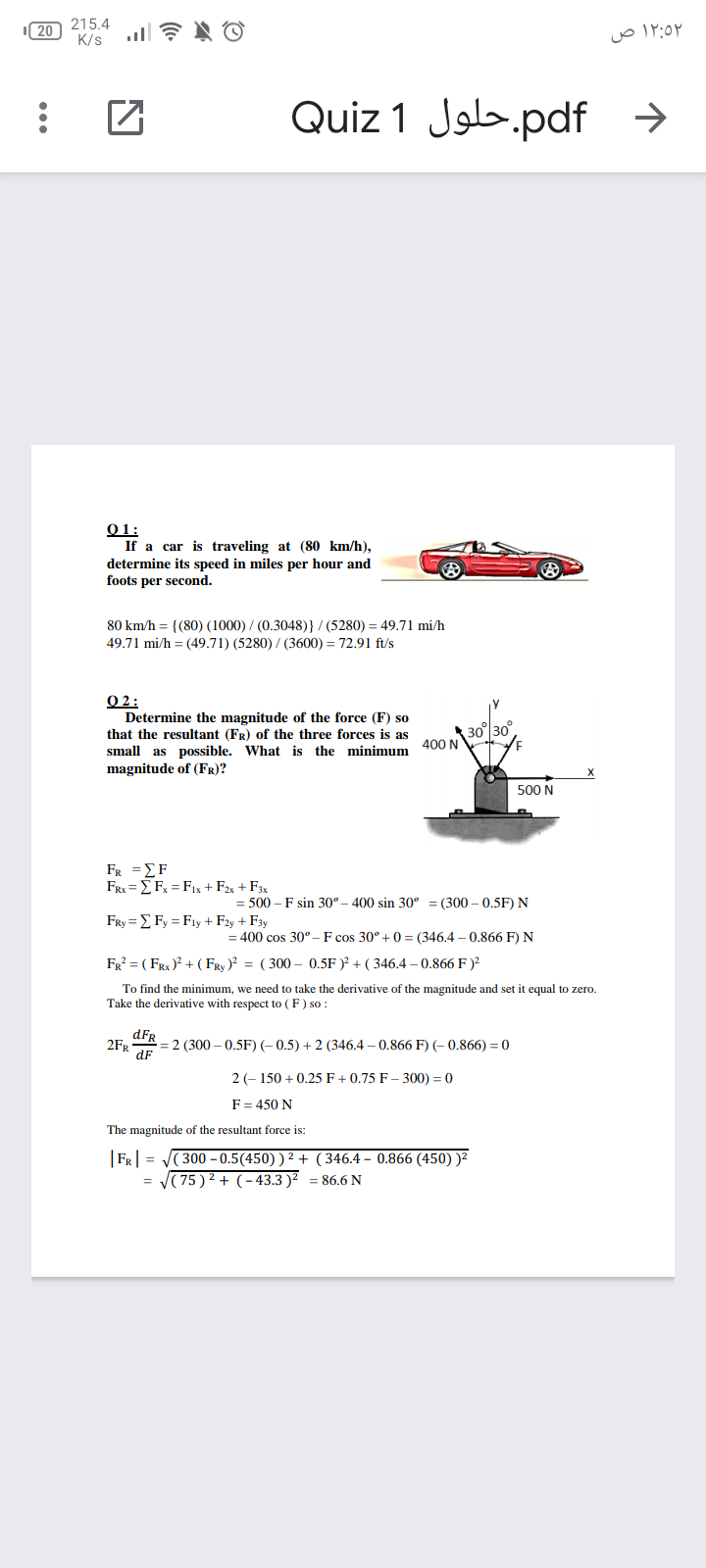Principles of Physics: A Calculus-Based Text
5th Edition
ISBN:9781133104261
Author:Raymond A. Serway, John W. Jewett
Publisher:Raymond A. Serway, John W. Jewett
Chapter1: Introduction And Vectors
Section: Chapter Questions
Problem 7OQ: One student uses a meterstick to measure the thickness of a textbook and obtains 4.3 cm 0.1 cm....
Related questions
Question

Transcribed Image Text:215.4
K/s
20
۱۲:۵۲ ص
Quiz 1 Job.pdf >
01:
If a car is traveling at (80 km/h),
determine its speed in miles per hour and
foots per second.
80 km/h = {(80) (1000) / (0.3048)} / (5280) = 49.71 mi/h
49.71 mi/h = (49.71) (5280) / (3600) = 72.91 ft/s
O 2:
Determine the magnitude of the force (F) so
that the resultant (FR) of the three forces is as
30
400 N
small as possible. What is the minimum
magnitude of (FR)?
500 N
FR ΣF
FRx = E Fx = F1x + F2x + F3x
= 500 – F sin 30°– 400 sin 30° = (300 – 0.5F) N
FRy = E Fy = Fıy + F2y + F3y
= 400 cos 30°- F cos 30° +0= (346.4 – 0.866 F) N
FR? = ( FRx)? + ( FRy )? = ( 300 – 0.5F )? + ( 346.4 – 0.866 F )?
To find the minimum, we need to take the derivative of the magnitude and set it equal to zero.
Take the derivative with respect to (F) so :
dFR
= 2 (300 – 0.5F) (- 0.5) + 2 (346.4 – 0.866 F) (- 0.866) = 0
2FR
2 (- 150 + 0.25 F + 0.75 F – 300) = 0
F= 450 N
The magnitude of the resultant force is:
|FR| =
( 300 – 0.5(450) ) ² + (346.4 – 0.866 (450) )²
= (75 ) 2 + (-43.3 )² = 86.6 N
Expert Solution
This question has been solved!
Explore an expertly crafted, step-by-step solution for a thorough understanding of key concepts.
This is a popular solution!
Trending now
This is a popular solution!
Step by step
Solved in 2 steps with 1 images

Knowledge Booster
Learn more about
Need a deep-dive on the concept behind this application? Look no further. Learn more about this topic, physics and related others by exploring similar questions and additional content below.Recommended textbooks for you

Principles of Physics: A Calculus-Based Text
Physics
ISBN:
9781133104261
Author:
Raymond A. Serway, John W. Jewett
Publisher:
Cengage Learning

An Introduction to Physical Science
Physics
ISBN:
9781305079137
Author:
James Shipman, Jerry D. Wilson, Charles A. Higgins, Omar Torres
Publisher:
Cengage Learning

Astronomy
Physics
ISBN:
9781938168284
Author:
Andrew Fraknoi; David Morrison; Sidney C. Wolff
Publisher:
OpenStax

Principles of Physics: A Calculus-Based Text
Physics
ISBN:
9781133104261
Author:
Raymond A. Serway, John W. Jewett
Publisher:
Cengage Learning

An Introduction to Physical Science
Physics
ISBN:
9781305079137
Author:
James Shipman, Jerry D. Wilson, Charles A. Higgins, Omar Torres
Publisher:
Cengage Learning

Astronomy
Physics
ISBN:
9781938168284
Author:
Andrew Fraknoi; David Morrison; Sidney C. Wolff
Publisher:
OpenStax

University Physics Volume 1
Physics
ISBN:
9781938168277
Author:
William Moebs, Samuel J. Ling, Jeff Sanny
Publisher:
OpenStax - Rice University

Physics for Scientists and Engineers, Technology …
Physics
ISBN:
9781305116399
Author:
Raymond A. Serway, John W. Jewett
Publisher:
Cengage Learning